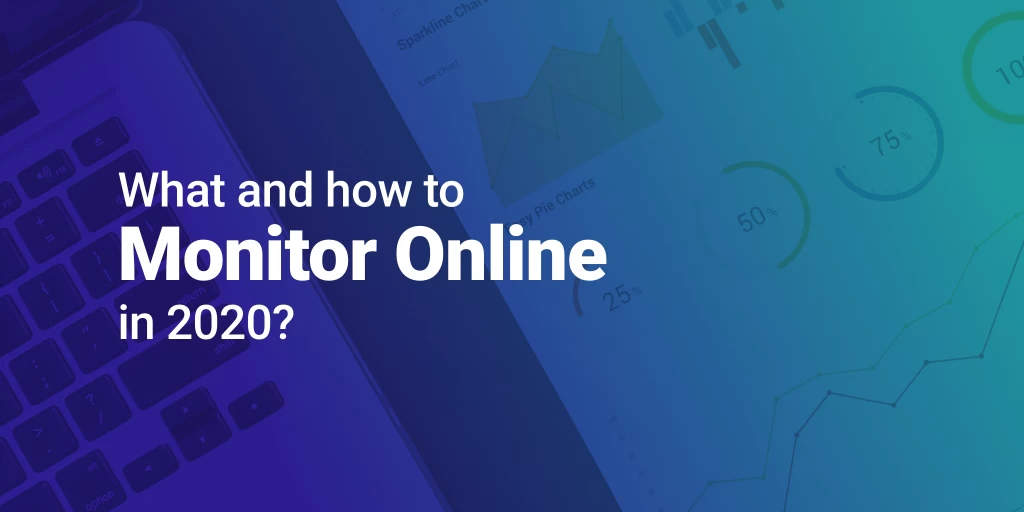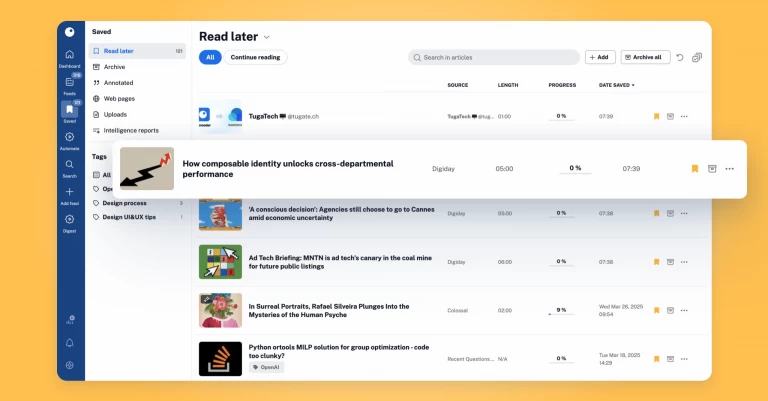What And How To Monitor Online In 2020?

Digital marketing achieves success only when you have the right data sets and insights as starting points. With everything being absolutely digital, you have no other choice than keep an eye on the conversations happening online. Social media listening and brand monitoring reveal not just your standing with your customer, but broader industry trends as a whole.
But what should we monitor? That’s a bit more complicated, because you have to set the specific goals you want to achieve at any given moment. Monitoring anything is a waste of time and other resources when the strategic component is missing. We can’t teach you this, but what we can do is touch upon the foundations of brand monitoring.
Why is it perhaps the most useful tool you can have in your arsenal and what are the components that should not be overlooked at any cost?
Why do you need to monitor your online reputation?
In business, reputation means everything. We don’t need to tell you this, you already know that a solid reputation does the selling for you over a longer period. However, we want to emphasize on the opportunities social listening and online monitoring create for marketers to strengthen brand health and longevity no matter what industry you operate in.
Careful observation into what clients think about your brand and more importantly why they think the way they do reveals new marketing strategies. The questions you can answer include:
- What has made our most recent campaign a success?
- What attracts customers to our products in particular?
- What unique quality helps our brand stand out in comparison to the competition?
- Where can we hope to improve?
Without answers to these questions, you’re navigating your niche without a clear direction and no brand can survive long enough being oblivious to their customer base. It’s fairly easy to fall into a false sense of customer understanding, where you create your own narrative about your brand and its impact, which most likely doesn’t correspond to the reality.
Don’t fall into this pitfall.
Know what people are saying about you
Customer feedback – this is what every marketing professional covets! It’s what your branding is built upon and what your marketing strategy will look like in the upcoming months and year. Now more than ever, companies have access to their customers’ opinions and the financial barrier has never been lower to acquire it. No longer do you have to delegate a large budget to research what your customer base thinks about you.
Just log online and perform a few quick searches of your brand name and you’ll get raw, unfiltered adulations and criticisms all at once. Overwhelming to wade through, yes. Absolutely necessary to retain your market positions today. The pace at which things change in any given industry has rapidly increased, so companies now are obligated to demonstrate flexibility based on trends and customer feedback.
It’s simple. You can’t steer the conversation, when you don’t know what the conversation is. The insights to be gained from brand monitoring affect everything from your ranking for keywords to future promotions to defining your core value proposition to improving your relationship with your customers.
Anticipate and control the buzz
Publicity isn’t something that happens to brands (at least it shouldn’t be) – it’s earned, controlled and redirected in ways, which support your business goals. Many say there’s no such thing as bad publicity, and that may be so in some instances, bad publicity can sink entire businesses. Can you forget how the documentary Blackfish decimated attendance rates at Seaworld and its reputation has never been the same ever since.
Obviously, we’re talking at a much smaller scale here, but the principle is the same. Reputation is everything to a brand, especially now when customers are more vocal than ever and eager to cancel everything and everyone. Monitoring your reputation gives you opportunities to fix small cracks in your image before they break the dam open and result in a PR fiasco. Last thing anyone wants is to trend on Twitter (often it’s for the worse).
Through monitoring tools and early PR efforts, any company can continuously mold their image and earn good faith over time.
Keep an eye on competition
Rather than direct your attention solely onto your brand, we advise you never lose sight of what your competitors have been up to. Companies don’t operate on the assumption there’s no one else on the market. Business is inherently competitive and your competition supplies the most valuable data on how to proceed at any given moment.
Smaller fish investigate the publicity decisions and messaging of movers and shakers in order to better position themselves as an up-and-comer. Big, established brands have tapped into what the public wants and more often than not dictate consumer tastes themselves. It pays off to identify what sells, translate it to your brand and repurpose to your own marketing strategy.
Veteran brands run the risk of growing self-involved and complacent in their position as a market leader – a potent recipe for disconnection from customers and changing attitudes. Look into what start-ups and new competitors have to say. Often fresh blood on the scene means innovations and value chain disruptions. Steal what you can and lend it your platform to maximize on its value.
At the very least, monitoring your competitors helps avoid having to release the same type of new product at the same time as your competitors or run competing campaigns. Or maybe you want to create such chaos.
What do you need to monitor online in 2020?
A significant question with multiple answers and no single correct answer. The choice you make is pre-determinant on so many factors.
Situation: Are you a company, which is experiencing a drop in sales and engagement?
Solution: You’re going to have to find out more about your brand reputation and look into reviews.
Situation: Are you a small brand, which wants to find footing in a local market?
Solution: Your monitoring needs to focus on your region as well as the competitors you’ll face on a local level.
Situation: Have you just made your entry onto the scene and want to gain insights into initial buzz and growth rate over time?
Solution: Create Google Alerts for your brand name and products, and put more emphasis on your social media presence as you’re building your audience.
As you see, you can have completely different scenarios and monitoring strategies. What’s more there are specialized tools for each goal out there, which proves how versatile monitoring is as a tactic. With so many choices, you might feel stuck onto where to start, but there are three essential pillars to consider:
Monitor keywords
Keywords are a brand’s best friend – PPC campaigns rely on them, SEO’s entire existence hangs on positioning your web pages on the first page of a search result and brand monitoring examines your company’s standing with customers. A consistent keyword research and monitoring over time consolidates all your digital marketing efforts and gives them further momentum.
Research and adapt to the changing landscape online in order to remain relevant. Your success has to do with how well you perform for certain important keywords. You don’t rank means you might even exist, because no one will ever be able to find you. Just as athletic goods stores come up on the first page when you type athletic shoes, you want customers to be able to find your brand even if they don’t know the name yet. To that, it’s extremely important you don’t miss out on the non-branded keywords related to your business.
You should remember keyword monitoring does more than reveal your rankings – it also shows what keywords are falling out of fashion and what are gaining popularity, which is also a result of changes in web search technology. You’re also in a position to learn how to alter your content to gain better ranking and engagement out of your audience.
Monitor your brand
Brand monitoring online is essential today, has been for the past five years and will be foundational for any and all marketing strategies in the year to come. The process is extensive as there are a lot of platforms and stages where your fans and haters will speak freely about your brand, products and campaigns. We have seen large companies not really pay attention to their reputation and see how their earnest efforts to drum up positive engagement have completely backfired.
Maybe you’ve heard about the McDonald’s fiasco, when they launched the now-infamous hashtag #McDStories. What was supposed to be a heartwarming conversation about how McDonald’s was integral to family memories turned into a public airing of grievances. A PR nightmare that could have been avoided. But that’s one example. Let’s take a moment of silence over other ill-conceived hashtags – #AskSeaWorld, #myNYPD, #AskJPM.
Through brand monitoring over forums, review sites, industry publications and think pieces, you gain a deeper, fuller understanding of the social sentiment towards your brand. If people are not all that into your brand, then maybe you should hold off from starting your own hashtag. Rather learn how to rehabilitate and meet customers’ needs.
Monitor your social media presence
Although positioned last, this doesn’t diminish the true importance social media possesses for companies to maintain longevity and convert leads to sales. Did you know that more than 60% of all brand mentions happen over on Twitter? You can’t ignore the impact your Twitter, Instagram and Facebook profiles and pages have on your brand’s success and that’s why you should keep an eye out on how your customers and potential customers react to your presence on social media.
Yes, this certainly applies to direct mentions and engagement statistics. It’s important to see what types of posts and language prompt users to share, like and comment. If you share content that has no engagement, have you even posted content in the first place? Monitoring direct interactions or the lack thereof signals the health of your brand and gives you insights into the customer mind-sight at this particular moment in time. You have monitoring tools, which specialize in gathering such data, but also build on top of this metric and seek out other conversations concerning your brand on social media channels. After all, not everyone is going to tag you directly in a conversation, but that doesn’t mean you can’t do a little bit of eavesdropping.


